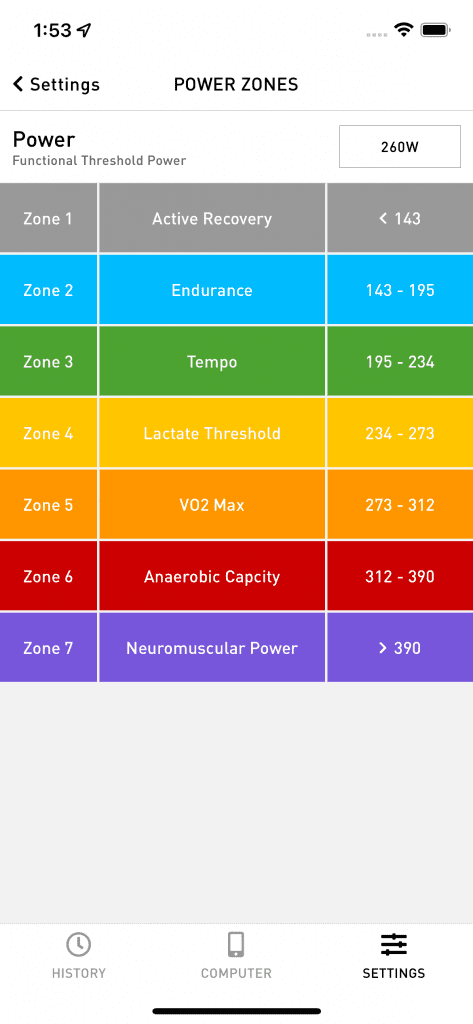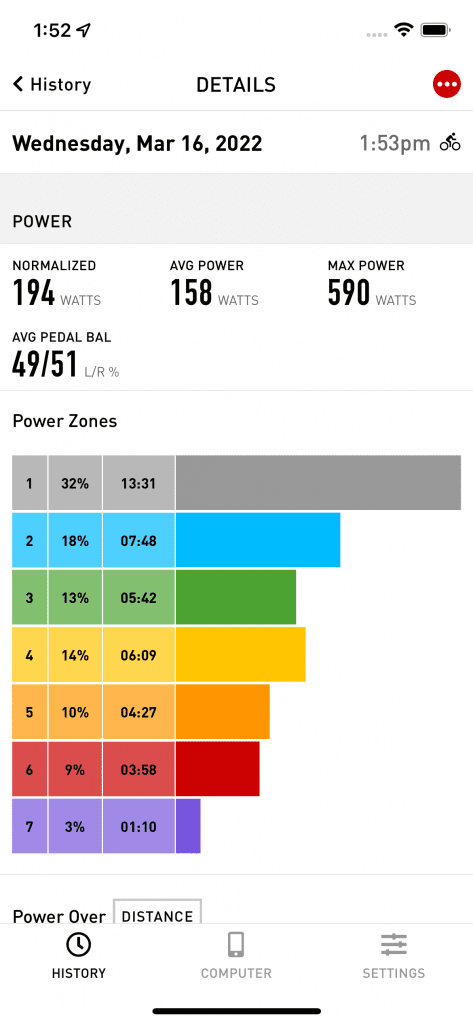If you’re looking to improve your cycling performance, power zone training is an excellent method to get you there.
Although power zone training has been around for decades, it is still the most effective and reliable way of improving performance on a bike. It was originally developed for elite cyclists, but riders at any level can use it to improve their skills.
Power zone training involves using a power meter (a device that measures your power output) and structured workouts based on seven different intensity zones that are specific to each rider’s fitness level and current abilities. These zones are measured in functional threshold power (FTP). Don’t have a power meter yet? Check out our power meter recommendations.
What are the Power Zones
Developed by a Dr. Andrew Coggan., these are the seven zones and how they’re defined:
Zone 1: Active Recovery (0-55 percent of FTP)
This is an easy zone for you to spend most of your time. You can talk in full sentences and never feel breathless. You’re using fat as your primary fuel source here. This zone is ideal for recovery and warming up/cooling down.
Zone 2: Endurance (56-75 percent of FTP)
This is the go-to power range for base training and low intensity riding. It’s a good place to start when you begin building more structured workouts into your training plan. If you only have time for one workout each week—or, if you have a busy week where getting out on the bike is impeded by other obligations—make that ride count with an hour or so spent in this zone.
Zone 3: Tempo (76-90 percent of FTP)
If you want to build endurance, this is about as hard as you should go in every workout according to experts at TrainingPeaks. This zone is a common work zone when building endurance fitness during base periods before moving on to more specific workouts later in the season. Time spent here will help improve capillary density and lactate threshold.
Zone 4: Lactate Threshold (91-105 percent of FTP)
Riding near or just under lactate threshold (the average power output from a rider’s best hour performance), Zone 4 is considered tempo riding because it can be sustained for up to 60 minutes without sacrificing form or fitness; however, it is not sustainable over multiple hours at a time except by experienced racers who have specifically trained their body’s ability to maintain this effort level over long periods of time. This puts Zone 4 right around what some call “sweet spot” training—riding at a mid-range intensity that doesn’t totally crush you.
Zone 5: VO2 max (106-120% of FTP)
Imagine you are the race leader. You’ve been pushing hard for the last two miles, and your competitor is just a few bike lengths behind you. You can feel them breathing down your neck. Your legs are burning, but there’s no time to back off now. The finish line is near, and you’re going full gas to take the win.
That’s Power Zone 5—or VO2 max training as it’s more commonly known—in a nutshell: interval training at or very near your functional threshold power (FTP), in this case 106-120% of FTP. It’s the most intense type of power zone workout you’ll do, and it should only be performed when fully recovered from prior workouts.
Zone 6: Anaerobic Capacity (.121% of FTP)
Zone 6 is an all-out effort that can only be held for up to one minute before recovery is needed. This zone has a wide range (117-150% of FTP) and even further subzones: high zone 6 (117-129% of FTP) and low zone 6 (130-150% of FTP).
Zone 7: Neuromuscular Power
This last zone is the most intense possible effort lasting from 1 second to 30 seconds. This anaerobic effort uses your body’s ATP/CP system (phosphagen), which provides energy very quickly by breaking down stored creatine phosphate into ATP at a rate faster than any other process in your body.
Benefits of Power Zone Training
Power Zone Training is a fantastic tool for measuring progress, monitoring fitness and training for certain events. Let’s break those down one by one:
- Measuring progress: By tracking the progress you’ve made over time, you’ll know whether your training is effective. If you’re not improving in some areas, it’s time to revise your training plan.
- Monitoring fitness: You can track power zone-related numbers and see how they change over time. If you’re high on your FTP but low on VO2 Max, then you may need to train intensity more than volume. By tracking these metrics, you can identify where you’re strongest (and weakest) so that you can focus your training efforts more effectively.
- Training for events: Knowing what power zone each of the different race intensities correspond to can help guide your training when preparing for particular races or specific challenges.
Setup your Power Zones in Cadence
Cadence automatically sets your power zones based on your functional threshold power. Once set, you can view your current zone during an activity and see how much time you spent in each zone at the end of your ride. You can even setup Voice Announcements to speak your current, split, or average power zone at specified intervals.


Download Cadence for iPhone or Android!
Note: various product links may be affiliate links, so if you purchase through them, I’d make a small commission.



